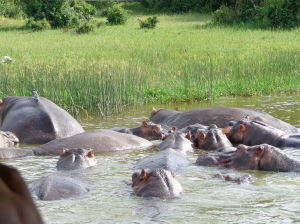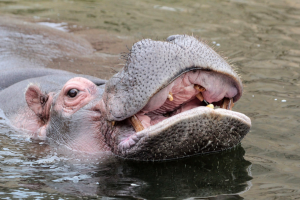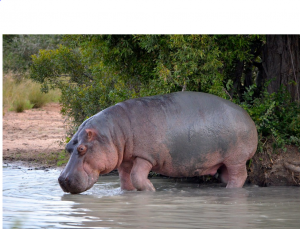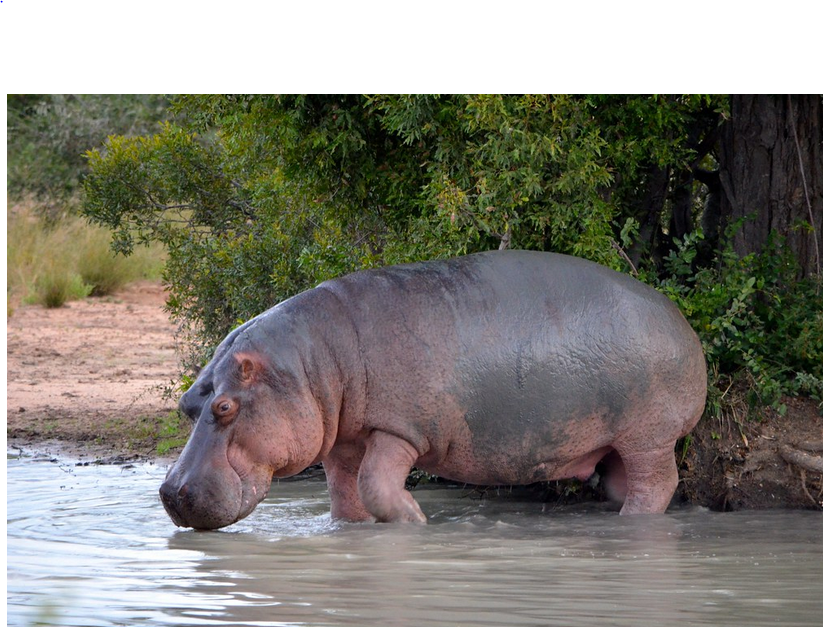The hippopotamus Facts
The hippopotamus Facts
The hippopotamus Facts : also know as (Hippopotamus amphibius) is a semiaquatic mammal found in Africa. It is one of the only two species in the family Hippopotamidae namely; the common or river hippo and the pygmy hippo. Generally, the river hippo is the larger of the two and its populations are concentrated in sub-Saharan Africa. On the other hand, the pygmy hippo, a native of West Africa, is both solitary and a nocturnal creature.
It basically lives in forested areas and survives on an herbivorous diet of grasses and leaves. Both species require the cooling, restorative powers of muddy waters as well as rivers. Above all, they spend much of their time with their bodies almost fully submerged. Although their skin appears to be rough and rugged, it is actually very sensitive to the intense sun and needs nearly constant hydration. Whilst the common hippo lives in large groups led by the most dominant male. Besides, pygmies prefer to stay on their own or in much smaller groups.
Hippopotamus Facts

They are one of the largest animals on the planet
Besides rhinoceros and the elephant, the common hippo is one of the biggest animal on planet earth. A fully-grown male can weigh up to 7,000 pounds while the female will generally weigh about 3000 pounds. At birth, baby hippos can weigh around 60 pounds, but it doesn’t take them long to gain weight. Surprisingly, in less than 3.5 years, a hippo is considered mature.
Hippos can’t swim
Hippos are always seen in water but actually can’t swim or float. They spend hours in rivers and lakes and sometimes with only their eyes showing. However, they remain in shallow waters and find sandy river banks and bottoms to stand on. Most of their foraging activity is done at night, since they’re nocturnal animals. During the heat of the day they strive to find a way to protect themselves from the midday sun. Furthermore, the water and mud act as a barrier to soothe their skin and regulate their temperatures.
Calves possibly suckle underwater
These animals are generally vegetarians although during the first year of life, calves nurse on milk from their mothers. Once they are born, they stay close to their mothers relying on them for food. This is done until they can survive on their own in the wild. They are also best known to ride on their mother’s backs sometimes. Interestingly, the hippo’s body has an adaptation to allow the calves to feed both on land and underwater. The eyes and nostrils close to prevent the calf from ingesting water and they can maintain this position for some good time.
Hippos can hold their breath
They have a unique lung structure that helps them to stay underwater without breathing for about 5 minutes. That means a hippopotamus needs to come up to the surface for air every 5 minutes. In most cases, the hippos tend to jump up from the river floor to the surface to take a breath. They also sink back down, and move forward along the bottom of a river bed. A thick membrane covers their eyes and their nostrils close, creating a protective water-tight seal. The species will do this when they sense danger or feel threatened by something in their environment. They may move to another area or just stay still until they feel it is safe to come back up to the surface. In fact, hippos are even able to sleep underwater using this same reflexive instinct.

Vocalizations
Hippos are basically very loud and use a series of noises to communicate with one another in their groups. These sounds are quite distinct and have been described as honks, whines, squeaks and growls. At times, it also resembles the sound of human laughter. On land, it is believed that their calls can be heard up to a mile away, although they have also been known to vocalize underwater. Nothing much is understood about what each call means or why they utter the sounds. But like other animals, it is their way of spreading messages. These include; alerting other hippos to danger, signaling a time to move or to stay still or even calling after their young ones.
Hippos are polygamous
These are species not known to mate for life and a male may obtain 10 mates in a lifetime. Since it’s the dominant male that rules the rest of the school, it’s always a challenge for younger males to secure a female to breed with. In a season, a male will usually mate with more than one female to ensure offspring. When young ones are born, they will all stay together in his territory. Here, he can protect, defend and shelter them from other competing males, intruders and predators.
Hippos can mate in the water
The basically mate every two years and most of the mating takes place in water. Both males and females use vocalizations, body language and even their own faeces and urine. In fact, this is done to display or show their interest or even to disapprove. Surprisingly, male will travel, compete, defend and fight other males in order to get the mate he wants. Regardless, only dominant and powerful hippos are allowed to mate successfully.

Gestation period
More like a human, female hippos have quite a long gestation period. Hippo’s gestation period is 8 months approximately 237 days and they will only have one baby at a time. The calf will remain besides its mother for approximately a year, suckling milk as it grows and gains strength. After some time, it will quit nursing and feed on vegetation.
They live in groups
These hippos are often found in large groups called schools and can consist of up to 100 hippos. This generally allows for safety and security and also gives males control over their families and territories. The main predators of hippo are crocodiles, hyenas as well as large cats which often opt to go after the smallest offspring. This is especially if they have wandered away from the protective groups and safe bounds.
Hippos mark their territories
Defending their territories is one of the reasons as to why hippos are considered dangerous. Female hippos will fiercely protect their young however the males who are most vicious and threatening. They will go after any hippo, animal or human that dares enter their personal territory or space. While on land, they may use their tails to launch their faeces around the area. This is done to specifically mark and show their territory to others. Other territory defending signals include loud noises, honking, yawning, wheezing, wide open mouths and charging. Besides smell reception of urine and dung showering, they also use the vomeronsal organ. This operates like an underwater syringe to draw in urine, to communicate or know the reproductive status of a male or female.
Where to find you in Uganda
While on your safari in Uganda, you are able to spot these animals in different national parks. These include; Queen Elizabeth National Park, Murchison Falls National Park, Lake Mburo National Park, etc.










Leave a Reply
Want to join the discussion?Feel free to contribute!